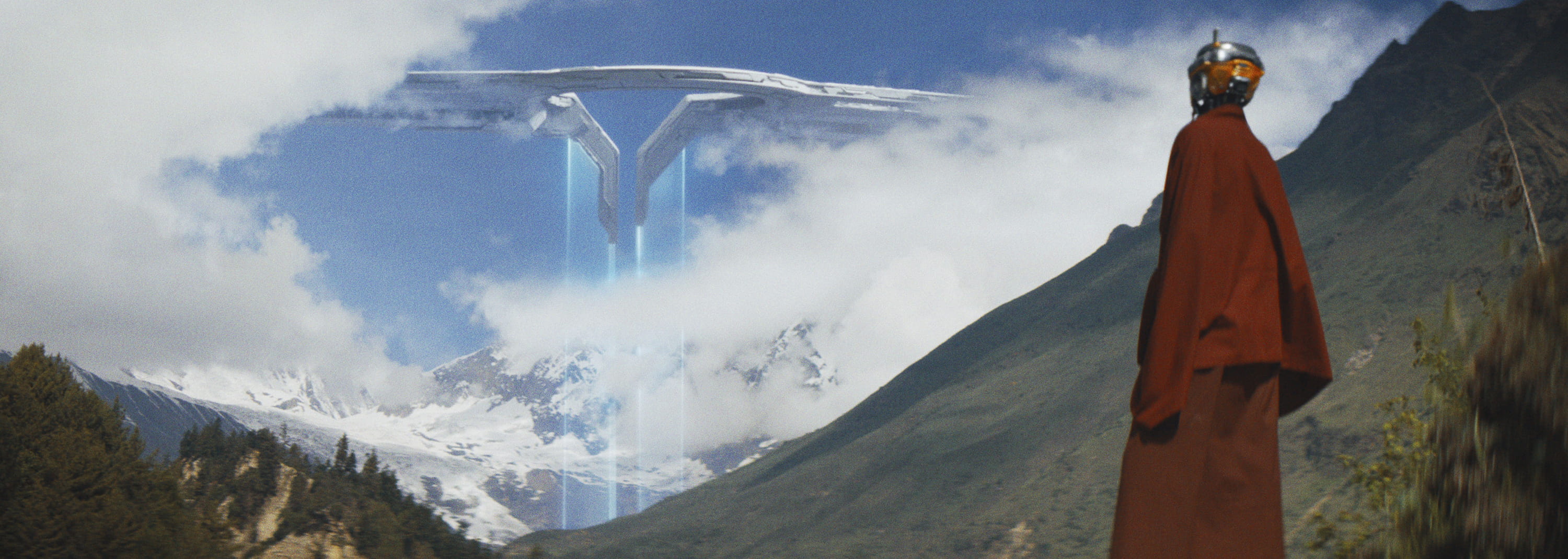
A robot monk gazes skyward at an American military space installation called Nomad in a scene from “The Creator.” (20th Century Studios/TNS)
When the first trailer for Gareth Edwards’ “The Creator” dropped, it seemingly promised a breath of fresh air into the sci-fi genre.
Manned by the director of “Rogue One, “The Creator” teased glimpses of stunning visuals most moviegoers would expect only of the biggest franchises, while also hinting at an original storyline.
While the movie does deliver with masterful cinematography, its hints of originality are nothing more than red herrings, as its story feels recycled and ultimately falls flat.
“The Creator” follows Joshua (John David Washington), a retired U.S. undercover operative who fought against rebellious, advanced and hyper-realistic artificial intelligence beings called Simulants.
Upon learning of a secret weapon the AI army has finished building with the potential to change the course of the ongoing war, Joshua — with his prior knowledge of the enemy’s defenses — is called back to action to help find and destroy the weapon.
The “twist” — if it can be called that, considering it was revealed in the film’s trailer — is that the weapon is actually a Simulant child (Madeleine Yuna Voyles) who has the ability to control electronic devices. The morals of the war become increasingly ambiguous as the movie progresses, and viewers learn more about the motivations of both sides.
“The Creator” looks stunning, and should be a favorite to win both Best Cinematography and Best Production Design at the next Oscars. What makes this feat even more impressive is that the film’s budget was only $80 million and was shot using an affordable Sony FX3. .
In comparison, recent MCU releases “Thor: Love and Thunder” and “Ant-Man and the Wasp: Quantumania” both had budgets of over $200 million, but nevertheless received immense criticism for poor CGI and unappealing visuals. By contrast, Edwards and cinematographer Greig Fraser (“Dune”), create a beautifully balanced, grounded world at a fraction of the cost.
Maybe the truly innovative triumph of “The Creator” lies not in some groundbreaking story, but rather in its ability to show studios that passion for a project beats out funding when it comes to CGI art and cinematography.
Though the visuals in “The Creator” impress, the plot falls flat on its face. For a movie that’s centered around AI, it’s ironic that ChatGPT probably could have written a better story.
The dialogue is at best clunky and at worst viscerally cringeworthy; it feels like there was no thought given to how lines would sound when actually spoken out loud, and instead screenwriters just went with whatever sounded interesting on paper.
The narrative borrows heavily from films like “Blade Runner,” “Avatar” and “Star Wars,” but “The Creator” doesn’t create anything new with the aspects it adopts and doesn’t seem to understand what made the elements of these franchises successful in the first place.
In particular, the main conflict of humans-vs-humanoids seems ripped directly from “Blade Runner,” but all of the philosophical questions it tries to raise were already posed in more nuanced and interesting ways 40 years ago. It’s also frustratingly familiar to “Star Wars,” even having a Death Star rip-off in the form of the Nomad, a massive ship that fires a death beam that the AI rebels seek to destroy.
“The Creator” seeks to prove a lot of points, whether about AI or the value of attention to detail in cinematography. But the biggest point it ends up proving is that no matter how beautiful a film looks, if the story doesn’t resonate with watchers, it’ll leave them feeling hollow.
“The Creator” steals more than it creates and will ultimately end up as just another forgettable sci-fi movie.
Rating: 3/5


